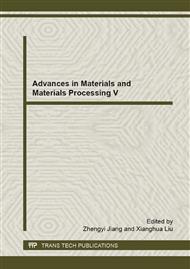p.603
p.608
p.612
p.616
p.620
p.626
p.631
p.636
p.641
Research on Induction Cladding Alloy Layer on the Surface of Steel Parts and its Performance
Abstract:
The method ofinduction cladding was adopted to make nickel-base layer on the surface ofsteel components in this test, and microstructure morphology, rigiditydistribution of the alloy layer made by cladding were analyzed and studied. Theresults shows that there is obvious bright white transition zone between thecladding alloy layer and the body, which forms an excellent metallurgicalbonding, microstructure of the alloy cladding layer is eutectic structure ofaustenite + carbide (austenite dendrite can be seen at individual parts), axialand radial rigidity are evenly distributed; bonding strength of cladding alloylayer is high without air hole and slag inclusion, with high flatness ofcylindrical surface, small machining allowance and low cost, etc.
Info:
Periodical:
Pages:
620-625
Citation:
Online since:
March 2015
Authors:
Price:
Сopyright:
© 2015 Trans Tech Publications Ltd. All Rights Reserved
Share:
Citation:


